Dairy Processing
25 Evaporation and Dehydration
The removal of water from foods provides microbiological stability, reduces deteriorative chemical reactions, and reduces transportation and storage costs. Both evaporation and dehydration are methods used in the dairy industry for this purpose. The following topics will be addressed here:
Evaporation
- Principle of Operation
- Evaporator designs
- Batch Pan
- Rising Film
- Falling Film
- Multiple Effect Evaporators
- Thermo compression
- Mechanical Vapour Recompression
Dehydration
- Spray Drying Process
- Powder Recovery
- Bag filters
- Cyclone collector
- Wet scrubber
- Two and Three Stage Spray Driers
- Principles of Fluid Beds
- Process
- Agglomeration and Instantizing
Evaporation
Principle of operation:
The driving force for heat transfer is the difference in temperature between the steam in the coils and the product in the pan. The steam is produced in large boilers, generally tube and chest heat exchangers. The steam temperature is a function of the steam pressure. Water boils at 100° C at 1 atm., but at other pressures the boiling point changes. At its boiling point, the steam condenses in the coils and gives up its latent heat. If the steam temperature is too high, burn-on/fouling increases so there are limits to how high steam temperatures can go. The product is also at its boiling point. The boiling point can be elevated with an increase in solute concentration. This boiling point elevation works on the same principles as freezing point depression.
Operating design:
Because milk is heat sensitive, heat damage can be minimized by evaporation under vacuum to reduce the boiling point. The basic components of this process consist of:
- heat-exchanger
- vacuum
- vapour separator
- condenser
The heat exchanger is enclosed in a large chamber and transfers heat from the heating medium, usually low pressure steam, to the product usually via indirect contact surfaces. The vacuum keeps the product temperature low and the difference in temperatures high. The vapour separator removes entrained solids from the vapours, channelling solids back to the heat exchanger and the vapours out to the condenser. It is sometimes a part of the actual heat exchanger, especially in older vacuum pans, but more likely a separate unit in newer installations. The condenser condenses the vapours from inside the heat exchanger and may act as the vacuum source.
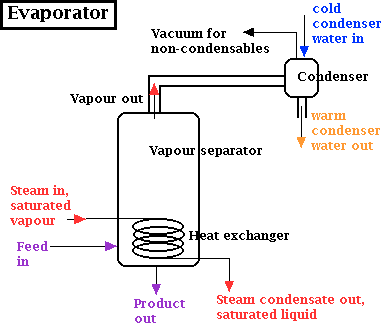
Evaporator Designs
- Batch Pan
- Rising film
- Falling film
- Plate evaporators
- Scraped surface
Batch pan evaporators are the simplest and oldest. They consist of spherical shaped, steam jacketed vessels. The heat transfer per unit volume is small requiring long residence times. The heating is due only to natural convection, therefore, the heat transfer characteristics are poor. Batch plants are of historical significance; modern evaporation plants are far-removed from this basic idea. The vapours are a tremendous source of low pressure steam and must be reused.
Rising film evaporators consist of a heat exchanger isolated from the vapour separator. The heat exchanger, or calandria, consists of 10 to 15 meter long tubes in a tube chest which is heated with steam. The liquid rises by percolation from the vapours formed near the bottom of the heating tubes. The thin liquid film moves rapidly upwards. The product may be recycled if necessary to arrive at the desired final concentration. This development of this type of modern evaporator has given way to the falling film evaporator.
The falling film evaporators are the most widely used in the food industry. They are similar in components to the rising film type except that the thin liquid film moves downward under gravity in the tubes. A uniform film distribution at the feed inlet is much more difficult to obtain. This is the reason why this development came slowly and it is only within the last decade that falling film has superceded all other designs. Specially designed nozzles or spray distributors at the feed inlet permit it to handle more viscous products. The residence time is 20-30 sec. as opposed to 3-4 min. in the rising film type. The vapour separator is at the bottom which decreases the product hold-up during shut down. The tubes are 8-12 meters long and 30-50 mm in diameter.
Multiple Effect Evaporators

Two or more evaporator units can be run in sequence to produce a multiple effect evaporator (shown on the right). Each effect would consist a heat transfer surface, a vapour separator, as well as a vacuum source and a condenser. The vapours from the preceding effect are used as the heat source in the next effect. There are two advantages to multiple effect evaporators:
- economy – they evaporate more water per kg steam by re-using vapours as heat sources in subsequent effects
- improve heat transfer – due to the viscous effects of the products as they become more concentrated
Each effect operates at a lower pressure and temperature than the effect preceding it so as to maintain a temperature difference and continue the evaporation procedure. The vapours are removed from the preceding effect at the boiling temperature of the product at that effect so that no temperature difference would exist if the vacuum were not increased. The operating costs of evaporation are relative to the number of effects and the temperature at which they operate. The boiling milk creates vapours which can be recompressed for high steam economy. This can be done by adding energy to the vapour in the form of a steam jet, thermo compression or by a mechanical compressor, mechanical vapour recompression.
Thermo Compression (TC)
Involves the use of a steam-jet booster to recompress part of the exit vapours from the first effect. Through recompression, the pressure and temperature of the vapours are increased. As the vapours exit from the first effect, they are mixed with very high pressure steam. The steam entering the first effect calandria is at slightly less pressure than the supply steam. There is usually more vapours from the first effect than the second effect can use; usually only the first effect is coupled with multiple effect evaporators.
Mechanical Vapour Recompression (MVR)
Whereas only part of the vapour is recompressed using TC, all the vapour is recompressed in an MVR evaporator. Vapours are mechanically compressed by radial compressors or simple fans using electrical energy.
There are several variations; in single effect, all the vapours are recompressed therefore no condensing water is needed; in multiple effect, can have MVR on first effect, followed by two or more traditional effects; or can recompress vapours from all effects.
Dehydration
Spray Drying – Process Summary
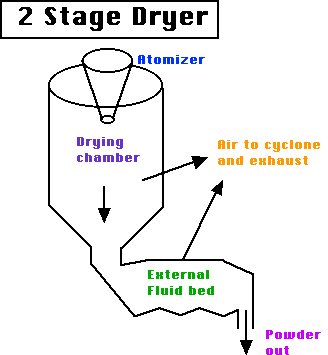
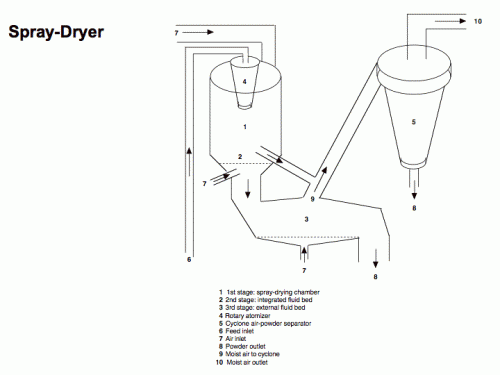
Principal components include:
- a high pressure pump for introducing liquid into the tower
- a device for atomizing the feed stream
- a heated air source with blower
- a secondary collection vessel for removing the dried food from the airstream
- means for exhausting the moist air
- usually includes a preconcentration step i.e. MVR evaporation
Atomizing devices are the distinguishing characteristic of spray drying. They provide a large surface area for exposure to drying forces:
1 litre = 12 billion particles = >300 ft2 (30m2)
The exit air temperature is an important parameter to monitor because it responds readily to changes in the process and reflects the quality of the product. Generally, we want it high enough to yield desired moisture without heat damage. There are two controls that may be used to adjust the exit air temperature:
- altering feed flow rate
- altering inlet temperature
If heat damage occurs before the product is dried, the particle size must be reduced; smaller particle dries faster, therefore, less heat damage. This can be accomplished in three ways:
- smaller orifice
- increase atomizing pressure
- reduce viscosity – by increasing feed temperature or reducing solids
Powder Recovery
Bag Filters
Bag filters are very efficient (99.9%), but not as popular due to labor costs, sanitation, and possible heat damage because of the long residence time. They are not recommended in the case of handling high moisture loads or hygroscopic particles.
Cyclone Separators
Cyclones are not as efficient (99.5%) as bag filters but several can be placed in series. Air enters at tangent at high velocity into a cylinder or cone which has a much larger cross section. Air velocity is decreased in the cone permitting settling of solids by gravity. Centrifugal force is important in removing particles from the air stream. High air velocity is needed to separate small diameter and light materials from air; velocities may approach 100 ft/sec (70 MPH). Higher centrifugal force can be obtained by using small diameter cyclones, several of which may be placed in parallel; losses may range from 0.5-2%. A rotary airlock is used to remove powder from the cyclone. (An example of a rotary airlock is a revolving door at a hotel lobby which is intended to break the outside and inside environments).
Wet Scrubbers
Wet scrubbers are the most economical outlet air cleaner. The principle of a wet scrubber is to dissolve any dust powder left in the airstream into either water or the feed stream by spraying the wash stream through the air. This also recovers heat from the exiting air and evaporates some of the water in the feed stream (if used as the wash water).
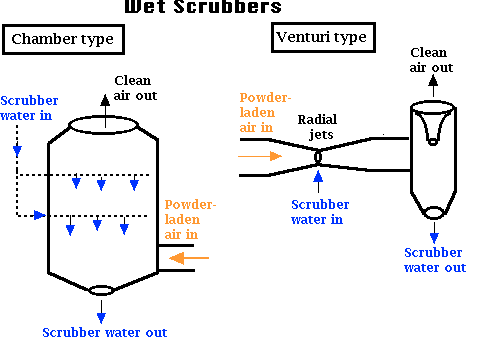
Wet scrubbers not only recover most of what would be lost product, but also recover approximately 90% of the potential drying energy normally lost in exit air. The exit air picks up moisture which increases evaporative capacity by 8% (concentration of feed). Cyclone separators are probably the best primary powder separator system because they are hygienic, easy to operate, and versatile, however, high losses may occur. Wet scrubbers are designed for a secondary air cleaning system in conjunction with the cyclone. Either feed stream or water can be used as scrubbing liquor. Also, there are heat recovery systems available.
Two and Three Stage Spray Drying With a Fluidized Bed
Air is blown up through a wire mesh belt on porous plate that supports and conveys the product. A slight vibration motion is imparted to the food particles. When the air velocity is increased to the point where it just exceeds the velocity of free fall (gravity) of the particles, fluidization occurs. The dancing/boiling motion subdivides the product and provides intimate contact of each particle with the air, but keeps clusters from forming.
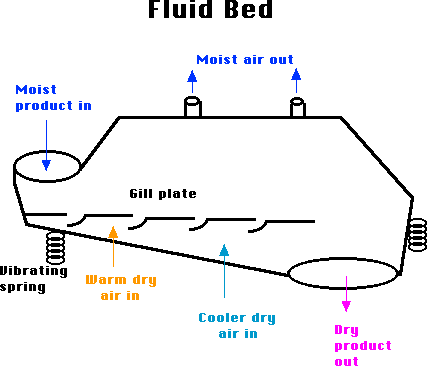
With products that are particularly difficult to fluidize, a vibrating motion of the drier itself is used to aid fluidization; it is called vibro-fluidizer which is on springs. The fluidized solid particles then behave in an analogous manner to a liquid., i.e. they can be conveyed. Air velocities will vary with particle size and density, but are in the range of 0.3 – 0.75 m/s. They can be used not only for drying but also for cooling. If the velocity is too high, the particles will be carried away in the gas stream, therefore, gravitational forces need to be only slightly exceeded.
Two- and three-stage drying processes
In standard, single stage spray drying, the rate of evaporation is particularly high in the first part of the process, and it gradually decreases because of the falling moisture content of the particle surfaces. In order to complete the drying in one stage, a relatively high outlet temperature is required during the final drying phase. Of course the outlet temperature is reflective of the particle temperature and thus heat damage .
Consequently the two stage drying process was introduced which proved to be superior to the traditional single stage drying in terms of product quality and cost of production.
The two stage drier consists of a spray drier with an external vibrating fluid bed placed below the drying chamber. The product can be removed from the drying chamber with a higher moisture content, and the final drying takes place in the external fluid bed where the residence time of the product is longer and the temperature of the drying air lower than in the spray dryer.
This principle forms the basis of the development of the three stage drier. The second stage is a fluid bed built into the cone of the spray drying chamber. Thus it is possible to achieve an even higher moisture content in the first drying stage and a lower outlet air temperature from the spray drier. This fluid bed is called the integrated fluid bed. The inlet air temperature can be raised resulting in a larger temperature difference and improved efficiency in the drying process. The exhaust heat from the chamber is used to preheat the feed stream. The third stage is again the external fluid bed, which can be static or vibrating, for final drying and/or cooling the powder. The results are as follows:
- higher quality powders with much better rehydrating properties directly from the drier
- lower energy consumption
- increased range of products which can be spray dried i.e., non density, non hygroscopic
- smaller space requirements
Agglomerating and Instantizing
Agglomeration Mechanism: Powder is wetted with water or steam. The surface must be uniformly wetted but not excessively. The powder is held wet over a selected period of time to give moisture stability to the clusters which have formed. The clusters are dried to the desired moisture content and then cooled (e.g., fluid bed). Dried clusters are screened and sized to reduce excessively large particles and remove excessively small ones. The agglomeration process causes an increase in the amount of air incorporated between powder particles. More incorporated air is replaced with more water when the powder is reconstituted, which immediately wet the powder particles.
Agglomerating Techniques
Rewet Methods:
This method uses powder as feed stock. An example is the ARCS Instantizer. Humidified air moistens powder, which causes it to cluster. It is re-dried and wetted. The clustered powder is then exposed to heated, filtered, high-velocity air. The dried clusters are then exposed to cooled air on a vibrating belt. It is then sized (pelleted to uniform size) and the fines are removed.
Straight Thru Process:
A multi-stage drying process produces powders with much better solubility characteristics similar to instantized powder. This method uses a low outlet temperature which allows higher moisture in powder as it is taken from spray drier with excess moisture removed in the fluid bed. The powder fines are reintroduced to the atomizing cloud in the drying chamber.
More information on specific evaporated and dehydrated products is located in the Dairy Products section.

